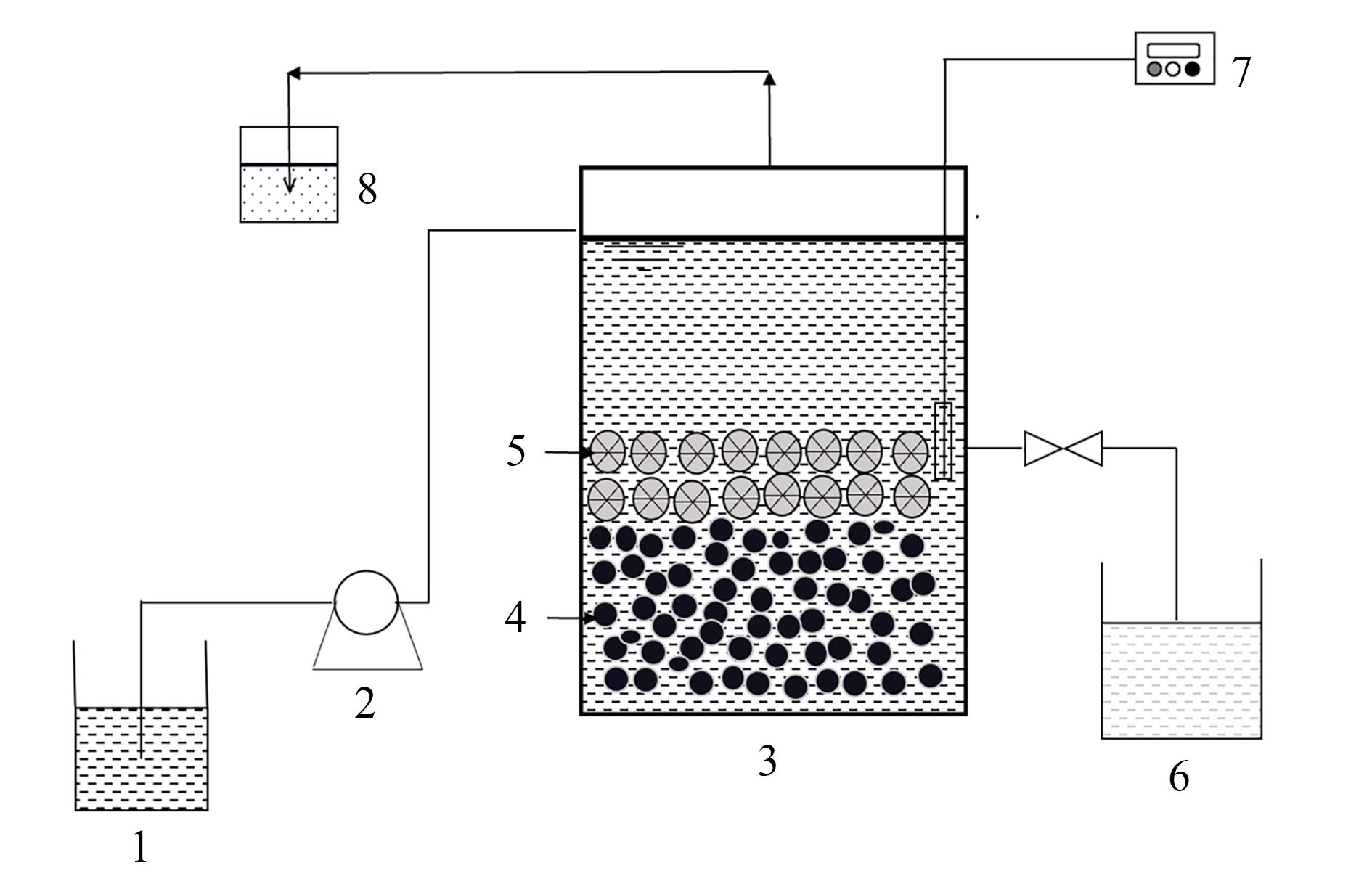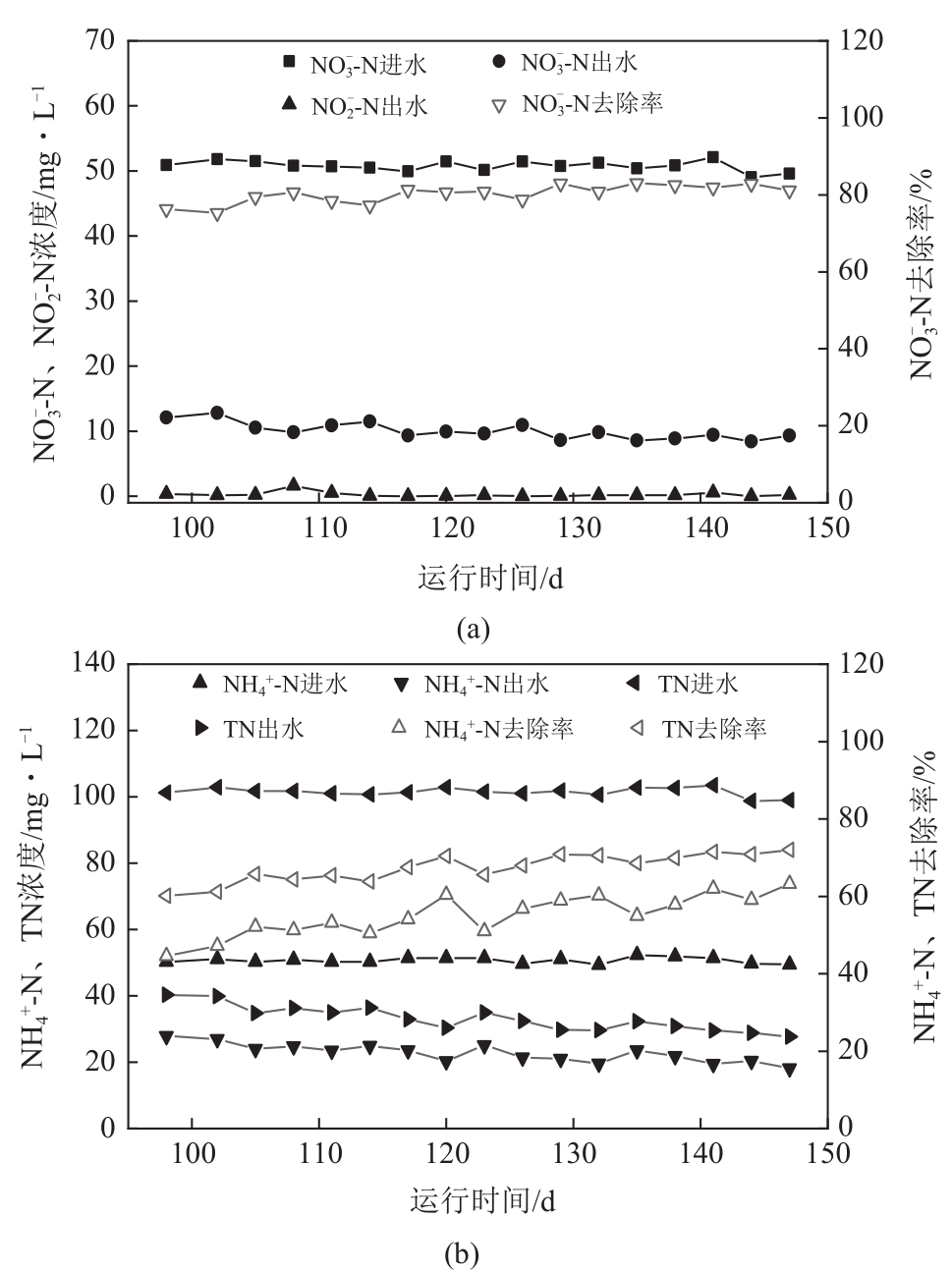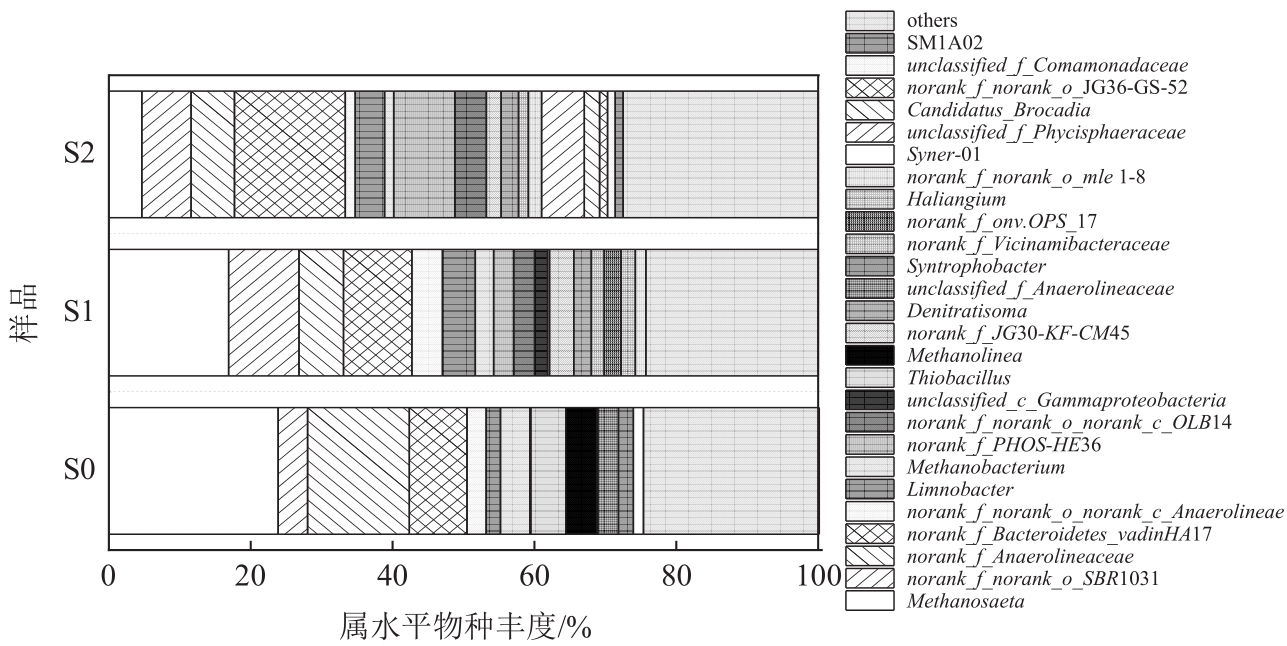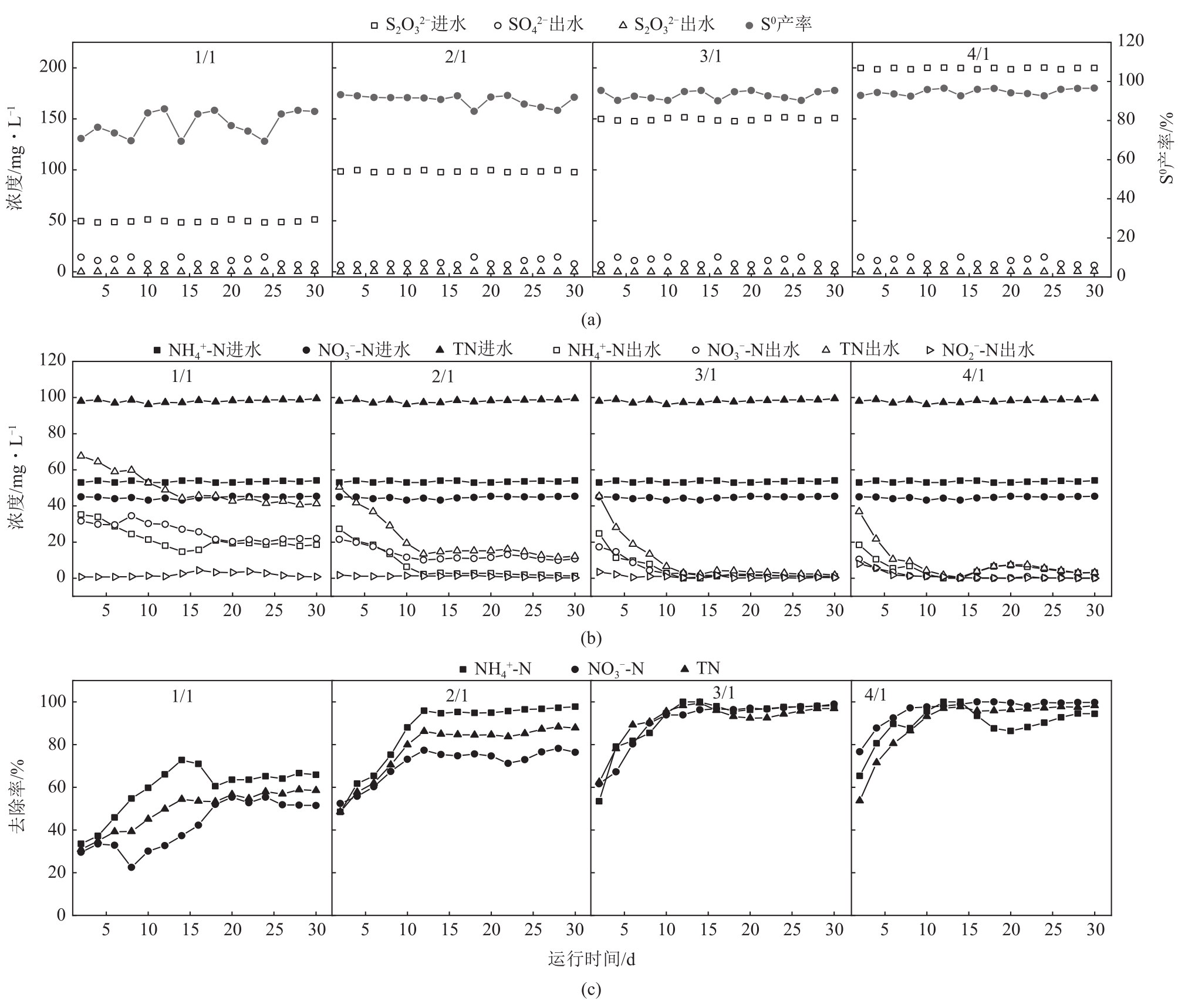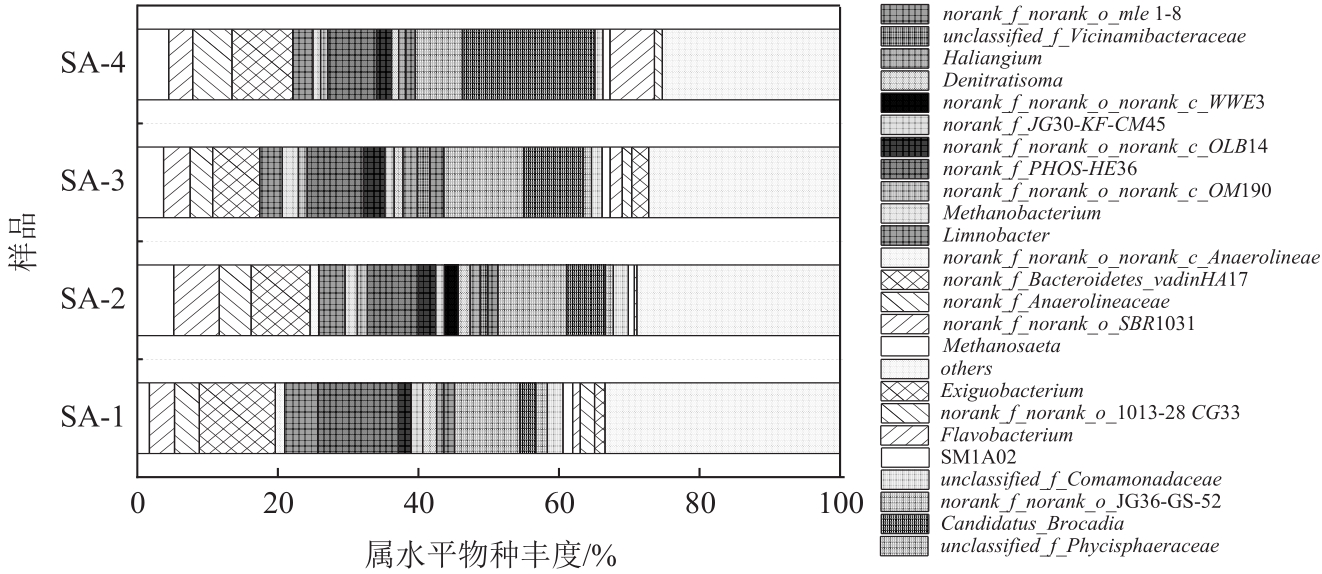化工进展 ›› 2023, Vol. 42 ›› Issue (6): 3261-3271.DOI: 10.16085/j.issn.1000-6613.2022-1448
SASD-A体系构建及进水不同S/N对脱氮工艺的影响机制
李白雪1( ), 信欣1,2(
), 信欣1,2( ), 朱羽蒙1, 刘琴1, 刘鑫1
), 朱羽蒙1, 刘琴1, 刘鑫1
- 1.成都信息工程大学资源环境学院,四川 成都 610225
2.中-塞环境与能源“一带一路”联合实验室,四川 成都 610225
-
收稿日期:2022-08-03修回日期:2022-11-03出版日期:2023-06-25发布日期:2023-06-29 -
通讯作者:信欣 -
作者简介:李白雪(1998—),女,硕士研究生,研究方向为污染治理及资源化。E-mail:1792176738@qq.com。 -
基金资助:成都市科技局技术创新研发项目(2022-YF05-00811-SN);山西省气象局科研项目(SXKZDDW20217105)
Construction of sulfur autotrophic short-cut denitrification and anaerobic ammonium oxidation (SASD-A) coupling system and effect mechanisms of influent S/N ratio on denitrification process
LI Baixue1( ), XIN Xin1,2(
), XIN Xin1,2( ), ZHU Yumeng1, LIU Qin1, LIU Xin1
), ZHU Yumeng1, LIU Qin1, LIU Xin1
- 1.School of Resources and Environment, Chengdu University of Information Technology, Chengdu 610225, Sichuan, China
2.China-Serbia Environment and Energy “Belt and Road” Joint Laboratory, Chengdu 610225, Sichuan, China
-
Received:2022-08-03Revised:2022-11-03Online:2023-06-25Published:2023-06-29 -
Contact:XIN Xin
摘要:
为了解决低碳或无机类工业废水中硝酸盐和氨氮含量高且难去除的问题,本实验采用厌氧反应器,接种普通厌氧颗粒污泥,以Na2S2O3为电子供体,通过逐渐提升进水NO3--N浓度的方式快速启动硫自养短程反硝化过程(SASD),然后,在此基础上加载附着厌氧氨氧化(Anammox)菌的填料,控制温度为(30±1)℃,经过147天的运行,构建了硫自养短程反硝化与厌氧氨氧化耦合工艺(SASD-A)。阐明了SASD和Anammox之间的相互作用和脱氮贡献率,探究了进水不同S/N(S2O32-:NO3--N)浓度比值对(SASD-A)体系脱氮效能的影响机制及微生物种群响应特性。结果表明:不同进水S/N比对SASD-A工艺脱氮性能影响明显,当进水S/N比为3/1时,NH4+-N、NO3--N和TN的去除率分别为91.49%、90.81%和91.44%。不同S/N对SASD-A耦合体系中功能菌属的相对丰度有着直接的关系,与脱氮功能相关的主要优势菌属有Limnobacter(2.85%~4.71%),Denitratisoma(1.01%~1.99%),Candidatus_Brocadia(2.28%~18.81%),norank_f_Bacteroidetes_vadinHA17(6.68%~10.81%),norank_f_PHOS-HE36 (6.93%~11.47%)等。批次实验表明,在SASD-A体系中,硫氧化菌以还原性Na2S2O3为电子供体,将其转化为S0和硫酸盐,同时将水体中硝酸盐还原为亚硝酸盐,产生的亚硝酸盐和氨氮在有厌氧氨氧化菌的作用下发生反应,生成气态氮,厌氧氨氧化在脱氮过程中占主导地位。
中图分类号:
引用本文
李白雪, 信欣, 朱羽蒙, 刘琴, 刘鑫. SASD-A体系构建及进水不同S/N对脱氮工艺的影响机制[J]. 化工进展, 2023, 42(6): 3261-3271.
LI Baixue, XIN Xin, ZHU Yumeng, LIU Qin, LIU Xin. Construction of sulfur autotrophic short-cut denitrification and anaerobic ammonium oxidation (SASD-A) coupling system and effect mechanisms of influent S/N ratio on denitrification process[J]. Chemical Industry and Engineering Progress, 2023, 42(6): 3261-3271.
| 阶段 | 时间/d | S2O32- /mg·L-1 | NO3--N /mg·L-1 | NH4+-N /mg·L-1 | pH | S2O32-: NO3--N |
|---|---|---|---|---|---|---|
| Ⅰ | 0~39 | 30 | 30 | — | 7.5~8.0 | 1∶1 |
| 40~95 | 50 | 50 | — | 7.5~8.0 | 1∶1 | |
| Ⅱ | 96~147 | 50 | 50 | 50 | 7.5~8.0 | 1∶1 |
表1 实验进水水质
| 阶段 | 时间/d | S2O32- /mg·L-1 | NO3--N /mg·L-1 | NH4+-N /mg·L-1 | pH | S2O32-: NO3--N |
|---|---|---|---|---|---|---|
| Ⅰ | 0~39 | 30 | 30 | — | 7.5~8.0 | 1∶1 |
| 40~95 | 50 | 50 | — | 7.5~8.0 | 1∶1 | |
| Ⅱ | 96~147 | 50 | 50 | 50 | 7.5~8.0 | 1∶1 |
| 32 | WANG Lukun. Study on nitrogen removal mechanism of anaerobic ammonium oxidation coupled with sulfur autotrophic short-range denitrification process for treating high-salt wastewater[D]. Qingdao: Qingdao University, 2020. |
| 33 | CHEN Wenjing, HU Fan, LI Xueting, et al. Deciphering the mechanism of medium size anammox granular sludge driving better nitrogen removal performance[J]. Bioresource Technology, 2021, 336: 125317. |
| 34 | LAWSON Christopher E, WU Sha, BHATTACHARJEE Ananda S, et al. Metabolic network analysis reveals microbial community interactions in anammox granules[J]. Nature Communications, 2017, 8(1): 15416. |
| 35 | WANG Shaopo, LIU Yuan, NIU Qigui, et al. Nitrogen removal performance and loading capacity of a novel single-stage nitritation-anammox system with syntrophic micro-granules[J]. Bioresource Technology, 2017, 236: 119-128. |
| 36 | ZHANG Zhengzhe, CHENG Yafei, LIU Yingyi, et al. Deciphering the evolution characteristics of extracellular microbial products from autotrophic and mixotrophic anammox consortia in response to nitrogen loading variations[J]. Environment International, 2019, 124: 501-510. |
| 37 | XU Lianzengji, ZHANG Quan, FU Jinjin, et al. Deciphering the microbial community and functional genes response of anammox sludge to sulfide stress[J]. Bioresource Technology, 2020, 302: 122885. |
| 38 | Jesús REYES-AVILA, Elı́as RAZO-FLORES, GOMEZ Jorge. Simultaneous biological removal of nitrogen, carbon and sulfur by denitrification[J]. Water Research, 2004, 38(14/15): 3313-3321. |
| 39 | 董颖. 基于厌氧氨氧化和自养反硝化耦合工艺同步脱氮除硫研究[D]. 济南: 山东大学, 2020. |
| DONG Ying. The study of the simultaneous removal of nitrogen and sulfide based on Anammox and autotrophic denitrification processes[D]. Jinan: Shandong University, 2020. | |
| 40 | DUAN Yuhan, JIANG Zhiwei, WU Zheng, et al. Limnobacter alexandrii sp. nov., a thiosulfate-oxidizing, heterotrophic and EPS-bearing Burkholderiaceae isolated from cultivable phycosphere microbiota of toxic Alexandrium catenella LZT09[J]. Antonie Van Leeuwenhoek, 2020, 113(11): 1689-1698. |
| 41 | HAN Yuchen, PERNER Mirjam. The globally widespread genus Sulfurimonas: versatile energy metabolisms and adaptations to redox clines[J]. Frontiers in Microbiology, 2015, 6: 989. |
| 1 | 邵桂霞, 本莲芳. 电化学氧化法处理化肥废水工艺研究[J]. 山东化工, 2018, 47(21): 189-190, 193. |
| SHAO Guixia, Lianfang BEN. Study on treatment of chemical fertilizer wastewater by electrochemical oxidation[J]. Shandong Chemical Industry, 2018, 47(21): 189-190, 193. | |
| 2 | 郑小发, 杨丽, 刁月, 等. 基于反向传播神经网络模型优化冶金废水单级脱氮试验研究[J]. 湿法冶金, 2021, 40(2): 167-173. |
| ZHENG Xiaofa, YANG Li, DIAO Yue, et al. Optimization of single-stage denitrification of metallurgical wastewater based on back propagation neural network[J]. Hydrometallurgy of China, 2021, 40(2): 167-173. | |
| 3 | 王长青, 张西华, 宁朋歌, 等. 含油废水处理工艺研究进展及展望[J]. 化工进展, 2021, 40(1): 451-462. |
| WANG Changqing, ZHANG Xihua, NING Pengge, et al. Research advances and perspective on treatment processes for oily wastewater[J]. Chemical Industry and Engineering Progress, 2021, 40(1): 451-462. | |
| 4 | 张懿文, 罗建中, 陈宇阳. 我国水体中硝酸盐的污染现状及危害[J]. 广东化工, 2015,42(14): 99-100. |
| ZHANG Yiwen, LUO Jianzhong, CHEN Yuyang. The pollution situation and harm of nitrate in water of China[J]. Guangdong Chemical Industry, 2015, 42(14): 99-100. | |
| 5 | ZHOU Xu, JIN Wenbiao, SUN Cuifang, et al. Microbial degradation of N,N-dimethylformamide by Paracoccus sp. strain DMF-3 from activated sludge[J]. Chemical Engineering Journal, 2018, 343: 324-330. |
| 6 | XU Lianzengji, XIA Wenjing, YU Minjie, et al. Merely inoculating anammox sludge to achieve the start-up of anammox and autotrophic desulfurization-denitrification process[J]. Science of the Total Environment, 2019, 682: 374-381. |
| 7 | STROUS M, HEIJNEN J J, KUENEN J G, et al. The sequencing batch reactor as a powerful tool for the study of slowly growing anaerobic ammonium-oxidizing microorganisms[J]. Applied Microbiology and Biotechnology, 1998, 50(5): 589-596. |
| 8 | STROUS Marc, PELLETIER Eric, MANGENOT Sophie, et al. Deciphering the evolution and metabolism of an anammox bacterium from a community genome[J]. Nature, 2006, 440(7085): 790-794. |
| 9 | DING Shuzhe, BAO Peng, WANG Bo, et al. Long-term stable simultaneous partial nitrification, anammox and denitrification (SNAD) process treating real domestic sewage using suspended activated sludge[J]. Chemical Engineering Journal, 2018, 339: 180-188. |
| 10 | KALYUZHNYI S V, GLADCHENKO M A, KANG H, et al. Development and optimisation of VFA driven DEAMOX process for treatment of strong nitrogenous anaerobic effluents[J]. Water Science and Technology, 2008, 57(3): 323-328. |
| 11 | LEE Dong Uk, Sung Hoon WOO, SVORONOS Spyros, et al. Influence of alternating oxic/anoxic conditions on growth of denitrifying bacteria[J]. Water Research, 2010, 44(6): 1819-1824. |
| 12 | ZHANG Lei, NARITA Yuko, GAO Lin, et al. Maximum specific growth rate of anammox bacteria revisited[J]. Water Research, 2017, 116: 296-303. |
| 13 | 邓旭亮, 王爱杰, 荣丽丽, 等. 硫自养反硝化技术研究现状与发展趋势[J]. 工业水处理, 2008, 28(3): 13-16. |
| DENG Xuliang, WANG Aijie, RONG Lili, et al. Present state of the sulfur-autotrophic denitrification technique and its developing trend[J]. Industrial Water Treatment, 2008, 28(3): 13-16. | |
| 14 | SAHINKAYA Erkan, DURSUN Nesrin. Use of elemental sulfur and thiosulfate as electron sources for water denitrification[J]. Bioprocess and Biosystems Engineering, 2015, 38(3): 531-541. |
| 15 | 杨世东, 祝彦均, 刘涵, 等. 不同氮硫浓度及氮硫比对硫酸盐还原厌氧氨氧化脱氮效果的影响[J]. 农业工程学报, 2021, 37(16): 199-204. |
| YANG Shidong, ZHU Yanjun, LIU Han, et al. Effects of N/S and ammonia concentrations on the process of sulfate reduction anaerobic ammonium oxidation[J]. Transactions of the Chinese Society of Agricultural Engineering, 2021, 37(16): 199-204. | |
| 16 | 张星星, 张钰, 王超超, 等. 短程反硝化耦合厌氧氨氧化工艺及其应用前景研究进展[J]. 化工进展, 2020, 39(5): 1981-1991. |
| ZHANG Xingxing, ZHANG Yu, WANG Chaochao, et al. Research advances in application prospect of partial denitrification coupled with anammox: a review[J]. Chemical Industry and Engineering Progress, 2020, 39(5): 1981-1991. | |
| 17 | LIU Shiyi, XIANG Yu, ZHOU Tengzhi, et al. Insight into thiosulfate-driven denitrification and anammox process: Bigger aggregates driving better nitrite utilization on ammonium and nitrate contained wastewater[J]. Journal of Water Process Engineering, 2022, 47: 102669. |
| 18 | 刘锋, 张雪智, 王苏琴, 等. 硫代硫酸盐驱动自养反硝化耦合厌氧氨氧化强化总氮去除[J]. 化工进展, 2022, 41(2): 990-997. |
| LIU Feng, ZHANG Xuezhi, WANG Suqin, et al. Thiosulfate-driven denitrification coupled with anammox to enhance total nitrogen removal[J]. Chemical Industry and Engineering Progress, 2022, 41(2): 990-997. | |
| 19 | QIAN Jin, ZHANG Mingkuan, WU Yaoguo, et al. A feasibility study on biological nitrogen removal(BNR) via integrated thiosulfate-driven denitratation with anammox[J]. Chemosphere, 2018, 208: 793-799. |
| 20 | SUN Xinbo, DU Lingfeng, HOU Yuqian, et al. Endogenous influences on anammox and sulfocompound-oxidizing autotrophic denitrification coupling system (A/SAD) and dynamic operating strategy[J]. Bioresource Technology, 2018, 264: 253-260. |
| 21 | DENG Yangfan, EKAMA George A, CUI Yanxiang, et al. Coupling of sulfur(thiosulfate)-driven denitratation and anammox process to treat nitrate and ammonium contained wastewater[J]. Water Research, 2019, 163: 114854. |
| 22 | 秦嘉伟, 信欣, 鲁航, 等. 连续流SNAD工艺处理猪场沼液启动过程中微生物种群演变及脱氮性能[J]. 环境科学, 2020, 41(5): 2349-2357. |
| QIN Jiawei, XIN Xin, LU Hang, et al. Bacterial community shifts and nitrogen removal characteristics for a SNAD process treating anaerobic digester liquor of swine wastewater (ADLSW) in a continuous-flow biofilm reactor (CFBR)[J]. Environmental Science, 2020, 41(5): 2349-2357. | |
| 23 | QIN Yujie, CAO Yan, REN Junyi, et al. Effect of glucose on nitrogen removal and microbial community in anammox-denitrification system[J]. Bioresource technology, 2017, 244: 33-39. |
| 24 | 国家环境保护总局《水和废水监测分析方法》编委会. 水和废水监测分析方法[M]. 4版. 北京: 中国环境科学出版社, 2002. |
| Editorial Board of Water and Wastewater Monitoring and Analysis Method, State Environmental Protection Administration. Methods for monitoring and analysis of water and wastewater[M]. 4th ed. Beijing: China Environmental Science Press, 2002. | |
| 25 | 王威, 毕志浩, 张若晨, 等. 自养反硝化脱氮耦合沼气同步脱硫效能研究[J]. 环境科学学报, 2019, 39(10): 3291-3301, 3565. |
| WANG Wei, BI Zhihao, ZHANG Ruochen, et al. The study on efficiency of autotrophic denitrification coupling biogas desulfurization simultaneously[J]. Acta Scientiae Circumstantiae, 2019, 39(10): 3291-3301, 3565. | |
| 26 | CHEN Chongjun, SUN Faqian, ZHANG Haiqing, et al. Evaluation of COD effect on anammox process and microbial communities in the anaerobic baffled reactor (ABR)[J]. Bioresource Technology, 2016, 216: 571-578. |
| 27 | WU Chenglong, QIN Yujie, YANG Lan, et al. Effects of loading rates and N/S ratios in the sulfide-dependent autotrophic denitrification (SDAD) and Anammox coupling system[J]. Bioresource Technology, 2020, 316: 123969. |
| 28 | 王衫允. 低氨氮浓度厌氧氨氧化工艺强化及颗粒污泥菌群特性研究[D]. 哈尔滨: 哈尔滨工业大学, 2016. |
| WANG Shanyun. Study on nitrogen removal enhancement and microbial characteristics of anammox in low-ammonia sewage treatment[D]. Harbin: Harbin Institute of Technology, 2016. | |
| 29 | XING Wei, LI Desheng, LI Jinlong, et al. Nitrate removal and microbial analysis by combined micro-electrolysis and autotrophic denitrification[J]. Bioresource Technology, 2016, 211: 240-247. |
| 30 | YANG Zh H, XIAO Y, ZENG G M, et al. Comparison of methods for total community DNA extraction and purification from compost[J]. Applied Microbiology and Biotechnology, 2007, 74(4): 918-925. |
| 31 | 姚松. 磷氮比对高氨氮废水短程硝化—反硝化处理效能及微生物种群分布的影响研究[D]. 北京: 北京交通大学, 2018. |
| YAO Song. Effect of P/N ratio on the treatment efficiency and microbial population communities of short-cut nitrification-denitrification treating high ammonia nitrogen wastewater[D]. Beijing: Beijing Jiaotong University, 2018. | |
| 32 | 王路坤. 厌氧氨氧化耦合硫自养短程反硝化工艺处理高盐废水的脱氮机制研究[D]. 青岛: 青岛大学, 2020. |
| [1] | 史天茜, 石永辉, 武新颖, 张益豪, 秦哲, 赵春霞, 路达. Fe2+对厌氧氨氧化EGSB反应器运行性能的影响[J]. 化工进展, 2023, 42(9): 5003-5010. |
| [2] | 陈娜, 张肖静, 张楠, 马冰冰, 张涵, 杨浩洁, 张宏忠. 淬灭酶对亚硝化-混合自养脱氮系统的影响[J]. 化工进展, 2023, 42(7): 3816-3823. |
| [3] | 李华华, 李逸航, 金北辰, 李隆昕, 成少安. 厌氧氨氧化-生物电化学耦合废水处理系统的研究进展[J]. 化工进展, 2023, 42(5): 2678-2690. |
| [4] | 朱紫旋, 陈俊江, 张星星, 李祥, 刘文如, 吴鹏. 基于短程反硝化厌氧氨氧化新型污水生物脱氮工艺的研究进展[J]. 化工进展, 2023, 42(4): 2091-2100. |
| [5] | 赵星程, 贾方旭, 蒋伟彧, 陈佳熠, 刘晨雨, 姚宏. 氧化还原介体介导厌氧氨氧化生物脱氮的研究进展[J]. 化工进展, 2023, 42(3): 1606-1617. |
| [6] | 吴新波, 党鸿钟, 马娇, 严渊, 曾天续, 李维维, 张国珍, 陈永志. A2/O-BAF工艺短程硝化模式下反硝化除磷效能[J]. 化工进展, 2023, 42(2): 1089-1097. |
| [7] | 张涵, 张肖静, 马冰冰, 佴灿, 刘烁烁, 马永鹏, 宋亚丽. 以城市废弃污泥为种泥启动厌氧氨氧化工艺的可行性[J]. 化工进展, 2023, 42(2): 1080-1088. |
| [8] | 池伟利, 杨宏. 厌氧氨氧化包埋填料处理稀土尾矿废水的中试脱氮和优化[J]. 化工进展, 2023, 42(1): 506-516. |
| [9] | 赵愉生, 崔瑞利, 牛贵峰, 赵元生, 程涛, 何盛宝, 宋俊男, 张霖宙. 俄罗斯渣油加氢处理技术开发与工业应用[J]. 化工进展, 2022, 41(7): 3582-3588. |
| [10] | 陈加波, 周鑫, 李旭. 以活性污泥为接种污泥厌氧氨氧化工艺的快速启动及脱氮效能[J]. 化工进展, 2022, 41(7): 3900-3907. |
| [11] | 王超超, 吴翼伶, 陈嘉巧, 蔡天宁, 刘文如, 李祥, 吴鹏. 新型厌氧水解酸化-短程反硝化厌氧氨氧化工艺同步处理生活污水和含硝酸盐模拟废水[J]. 化工进展, 2022, 41(7): 3890-3899. |
| [12] | 汪宇光, 张星星, 王超超, 夏云康, 王垚, 周澄, 吴翼伶, 吴鹏, 徐乐中. 反硝化除磷+短程反硝化厌氧氨氧化工艺的深度脱氮除磷效能[J]. 化工进展, 2022, 41(4): 2191-2201. |
| [13] | 刘锋, 张雪智, 王苏琴, 冯震, 葛丹丹, 杨洋. 硫代硫酸盐驱动自养反硝化耦合厌氧氨氧化强化总氮去除[J]. 化工进展, 2022, 41(2): 990-997. |
| [14] | 倪清, 来锦波, 彭东岳, 管翠诗, 龙军. 离子液体萃取分离烃类化合物的研究进展[J]. 化工进展, 2022, 41(2): 619-627. |
| [15] | 肖灿灿, 杨亚飞, 张耀斌. 针铁矿促进剩余污泥厌氧消化中的脱氮除碳[J]. 化工进展, 2022, 41(12): 6689-6697. |
| 阅读次数 | ||||||
|
全文 |
|
|||||
|
摘要 |
|
|||||
